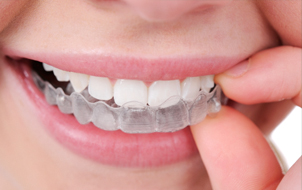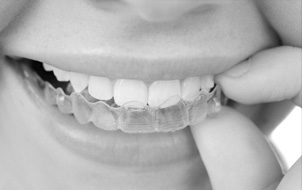Common Questions
What Is Orthodontics?
Orthodontics is the branch of dentistry that specializes in the diagnosis, prevention, and treatment of dental and facial irregularities. The technical term for these problems is “malocclusion,” which means bad bite. The practice of orthodontics requires professional skill in the design, application, and control of corrective appliances, such as braces or Invisalign, to bring teeth, lips and jaws into proper alignment to achieve facial balance.
What Is An Orthodontist?
An orthodontist is a dental specialist in the diagnosis, prevention and treatment of dental and facial irregularities. Orthodontists must first attend college, followed by a four-year graduate dental program at a university level dental school accredited by the American Dental Association (ADA). They must then successfully complete an additional two to three-year residency program of advanced dental education in orthodontics accredited by the ADA. Only dentists who have successfully completed this advanced specialty education may become an orthodontist.
What Causes Orthodontic Problems?
Most malocclusions are inherited, and some are acquired. Inherited problems include crowding of teeth, too much space between teeth, extra teeth, congenitally missing teeth, and a wide range of discrepancies of the jaws, teeth, and face. Acquired problems can be caused by trauma, thumb or finger sucking, airway obstruction by tonsils and adenoids, dental diseases, and premature loss of baby or adult teeth. Many of these problems affect not only the alignment of teeth but also facial development and appearance as well.
How Do I Know If My Child Needs Orthodontic Treatment?
It is usually difficult for you to determine if treatment is necessary because there are many problems that can occur even though the front teeth look straight. Also, there are some problems that look intimidating and complex which will resolve on their own. Asking your general dentist is a good reference, but we are your best resource since orthodontics is all we do. Our initial exam is comprehensive and informative, and we would be more than happy to see your child and make any recommendations necessary.
What Are The Early Signs Of Orthodontic Problems?
Although determining if treatment is necessary is difficult for you to assess, the following signs may help in prompting you to seek orthodontic advice: crowded or overlapping teeth, gaps between the teeth, protruding teeth, top front teeth not meeting with bottom teeth, and top front teeth covering more than 50% of the bottom teeth. If you see any misalignment or shifting of the jaw, your child may have a skeletal problem, which may require early orthodontic treatment. These are only some of the obvious signs of orthodontic problems.
At What Age Should My Child See An Orthodontist?
The American Association of Orthodontics recommends that your child be evaluated by age seven. An orthodontic screening no later than age seven enables the orthodontist to detect and evaluate problems that exist, advise if treatment will be necessary, and determine the best time for the treatment. Early detection of any orthodontic problems is important in order to take early corrective action and avoid more difficult treatment later.
Can Adults Have Braces?
Age is not a factor in considering orthodontic treatment for adults. Any adult in good general health with healthy gums and good bone support for the teeth is a candidate for orthodontic treatment. About 25% of our orthodontic patients are adults, and that number is still growing! Many of our adult patients are using Invisalign, a technique to straighten your teeth without braces, using a series of clear, removable aligners.
Is Orthodontic Treatment Painful?
Orthodontic treatment has improved dramatically. As a rule, braces make your teeth tender and sore for a few days, but it is not painful. This annoyance can be relieved with an over-the-counter analgesic such as Tylenol or Advil. Today’s braces are more comfortable and use technology that reduces the discomfort. We use the latest in biocompatible braces, the advanced technique with light force and the highest quality of orthodontic materials, in order to reduce discomfort and treatment time.
What Is Phase I (Interceptive) And Phase II (Comprehensive) Treatment?
Phase I, or Interceptive Treatment, usually starts while the child has a combination of both baby teeth and permanent teeth, usually the permanent front incisors. This stage in development is usually between the ages of 7 to 10. The goal of Phase I treatment is to intercept a moderate or severe orthodontic problem early in order to reduce or eliminate it. These problems include severe crowding and skeletal discrepancies, including overbites, underbites and crossbites.
Phase I treatment takes advantage of the early growth spurt and turns a difficult orthodontic problem into a more manageable one. This often helps reduce the need for extraction or surgery and delivers better long-term stability. In cases where the front teeth are protruding, trauma to these teeth can be prevented with Phase I treatment. Most Phase I patients require a second phase of treatment once all the permanent teeth have erupted in order to perfect the alignment of all the teeth and achieve an ideal bite.
Phase II treatment usually occurs a number of years later. Usually, we are waiting for the remaining permanent teeth to erupt before Phase II begins. This most commonly occurs at the age of 12. The goal of Phase II treatment is to achieve an ideal alignment and bite of all of the permanent teeth.
Phase I treatment takes advantage of the early growth spurt and turns a difficult orthodontic problem into a more manageable one. This often helps reduce the need for extraction or surgery and delivers better long-term stability. In cases where the front teeth are protruding, trauma to these teeth can be prevented with Phase I treatment. Most Phase I patients require a second phase of treatment once all the permanent teeth have erupted in order to perfect the alignment of all the teeth and achieve an ideal bite.
Phase II treatment usually occurs a number of years later. Usually, we are waiting for the remaining permanent teeth to erupt before Phase II begins. This most commonly occurs at the age of 12. The goal of Phase II treatment is to achieve an ideal alignment and bite of all of the permanent teeth.
Does Everyone Need A Phase I Treatment?
Not every child needs a Phase I treatment. Only some children with certain bites require early intervention. All others can wait until most, if not all, of their permanent teeth erupt. However, it is still important that every child be evaluated by age seven. Dr. Mibab will periodically monitor the dental growth and development at no charge.
What Is The Duration Of Orthodontic Treatment?
Each treatment varies depending on the development of the dentition, the severity of the problem, patient cooperation, and the degree of tooth movement required. Most Phase I treatment lasts 9-12 months and an average treatment time for Phase II is 18-24 months.
What Is The Difference Between Extraction And Non-Extraction Therapies?
Each treatment is a way to address crowding of the teeth. Extraction therapy is a technique where one or more permanent teeth are removed to make room for the other teeth in the mouth. This is in contrast to non-extraction therapy where one expands a patient’s jaw and/or adjusts the size and shape of some teeth to make them fit within the jaw. Our office’s treatment philosophy is very conservative, and we do make every effort to avoid extractions. However, for severe crowding and severe jaw discrepancy, the extraction approach may be required.
Is Orthodontic Care Expensive?
When orthodontic treatment is implemented at the proper time, treatment is often less costly than the dental care required to treat the more serious problems that can develop years later. Orthodontic fees have not increased as fast as many other consumer products. Mibab Orthodontics offers interest –free payment plans. Many payment programs are available, including automatic bank drafts, recurring charges to your credit card and coupon books for your monthly payments. In addition, many insurance plans now include orthodontic benefits.

























